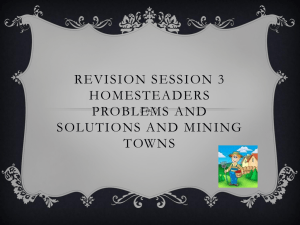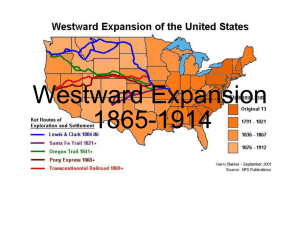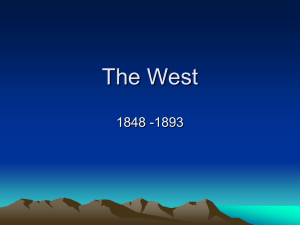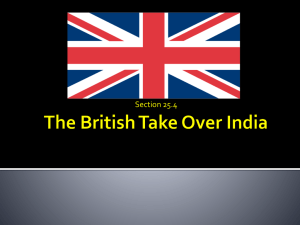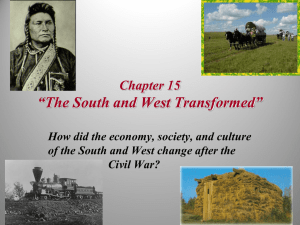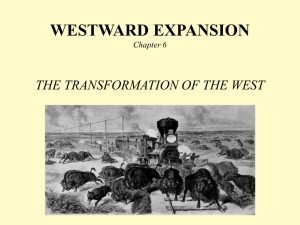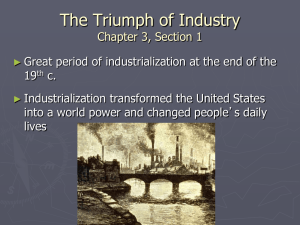File - Mr. Mick`s social studies
advertisement
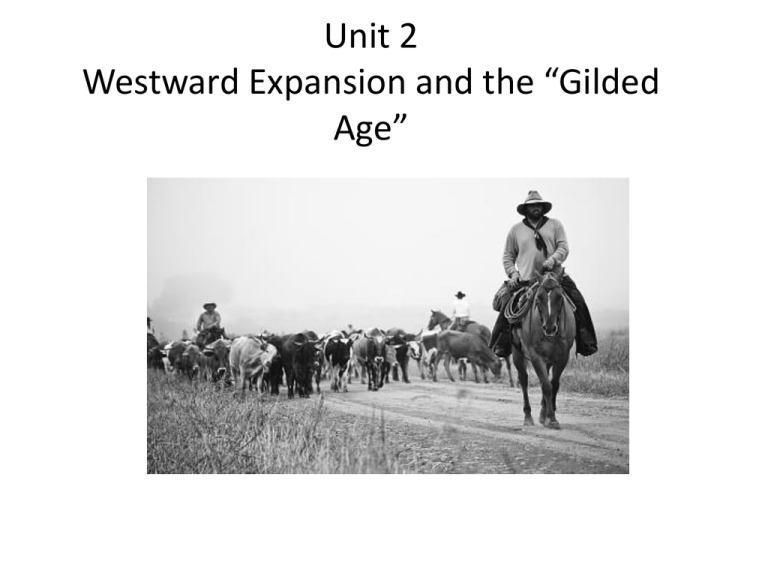
Unit 2 Westward Expansion and the “Gilded Age” Section 2-1 • Why was there a need for beef after the Civil War? – Eastern cattle had been slaughtered to feed the Union/Confederate armies • Cattle were available in Texas, (Longhorns) if you could round them up. • Who did this—Cowboys • Where did the Cowboys come from/ who were they? 1. 2. 3. Civil war vets looking for work Freed slaves Hispanics Section 2-1 • Cattle roamed free on the “open range,” vast open land owned by the federal government Section 2-1 • Cowboys found they could sell cattle for a huge profit, if they got them to the railroad – This resulted in cattle drives. • The most famous cattle drives were on the Chisholm Trail from Texas to Kansas Section 2-1 • Joseph Glidden ended the cowboy culture with the invention of barbed wire – How did barbed wire end the cowboy way of life? • Barbed wire was used by homesteaders (farmers/ranchers), who fenced off land, and blocked the cattle trails Note Quiz 1. Explain how barbed wire ended the cowboy culture, and cattle drives 2. What was the most famous cattle drive/trail? 3. Explain why there was a need for beef after the Civil War 4. Name 2 of 3 groups of people who became cowboys 5. Who invented barbed wire? 2-2: Miners, Homesteaders, and conflict with Indians • After the Civil War industries in the East wanted the gold, silver, and copper buried in mountains out west • An average person could strike it rich through placer mining, using pick axes, shovels, and pans • Big businesses got the precious metals and minerals by tunneling underground. This was known as quartz mining. 2-2: Miners, Homesteaders, and conflict with Indians • The rush for minerals and precious metals made white settlers rush out to small outposts in Nevada, Colorado, Arizona • These small outposts became crowded boomtowns overnight, rife with crime • When the gold/silver/copper disappeared, the boomtown became a “ghost town” 2-2: Miners, Homesteaders, and conflict with Indians • The area between the Mississippi River and the Rocky Mountains is known as the Great Plains – Vast rolling hills, or completely flat – Originally called “The Great American Desert,” – Ideal for growing wheat 2-2: Miners, Homesteaders, and conflict with Indians • Railroads gave settlers easier access to the Plains region • Homestead Act of 1862: legislation that allowed settlers to apply for a homestead – 10$ application – Got you • 160 acres of land that you owned after living on it 5 years • So, how did the railroad and the U.S. government encourage the settling of the Great Plains? 2-2: Miners, Homesteaders, and conflict with Indians • Dry farming was method for farming wheat – In dry farming farmers plant seeds down deep in soil, moisture allows them to grow • The first wave of homesteaders were nicknamed sodbusters. They often lost their farms due to drought, erosion, or misuse of the land • New technology makes wheat farming more profitable, Plains region becomes known as the “wheat belt” • Bonanza farms were huge wheat farms (more than 50k acres) that were very profitable. 2-2: Miners, Homesteaders, and conflict with Indians • 1860’s: Indians begin attacking miners, ranchers moving out west. Indians are gathered to negotiate peace, but are killed at the Sand Creek Massacre • By 1876, buffalo herds are gone. U.S. government tries to round up last bands of Sioux, Cheyenne Indians • George Custer and the 7th Cavalry are annihilated by 2,000 Sioux and Cheyenne at The Battle of Little Bighorn • It is the last great victory for Native Americans against the U.S. government 2-2: Miners, Homesteaders, and conflict with Indians • Final resistance to the U.S. government was violently crushed when over 250 men, women, and children were killed by the U.S. army at Wounded Knee Creek • The U.S. tried to get Native Americans to assimilate—adopt white culture, customs and English • The U.S. government encouraged this through the Dawes Act of 1887 – The Dawes Act tried to put Indians on homesteads, get them to farm like whites • Dawes Act was ultimately a failure – Native Americans didn’t want to give up their way of life Note Quiz 1. Explain how the Dawes Act tried to assimilate Native Americans into white culture? 2. What conflict was the final resistance to U.S. government by Native Americans? 3. What was a huge wheat farm that was very profitable called? 4. What was the nickname to outposts that turned into busy cities because of silver and gold? 5. What were two reasons that motivated people to settle on the Great Plains? The Rise and Fall of the Populist Party 1867-1896 Farmers’ Problems • Crop prices fell • Farmers had no cash, went further into debt, and their lenders foreclosed on their mortgages • The railroad companies charged outrageous prices to ship crops (no regulation!) 16 Farmers’ Demands • Regulate the railroad companies (Stop them from charging such high rates) • Make cash more available (back the dollar with silver, not gold, so dollar would be worth less) • Constitutional demands: single term for President and Vice-President, secret ballot, popular election of Senators • To get industrial workers to support them: 8-hour workday, restrict immigration 17 Different Groups Representing Farmers’ Interests • 1867: The Patrons of Husbandry (The Grange) • 1880s: Farmers’ Alliance and Colored Farmers’ National Alliance • 1892: Birth of the Populist, or People’s Party 18 1892 Presidential Election: Populist candidate won over a million votes! 19 1896 Election Democrats – 1890s • Southerners • Wealthy farmers • Supported low tariffs (wanted other countries to buy their crops) Republicans – 1890s • Northerners • Wealthy business men (connected to the railroad) • Southern African Americans (poor farmers) • Supported high tariffs (didn’t want to compete with other countries’ products) 20 1896 Election Populists decide to improve their chances by supporting the Democratic candidate, William Jennings Bryan, who agreed to support the silver-backed dollar. 21 1896 Presidential Election: Bryan loses but carries most of the South and West 22 Central Historical Question Why did the Populist Party attract millions of supporters?
